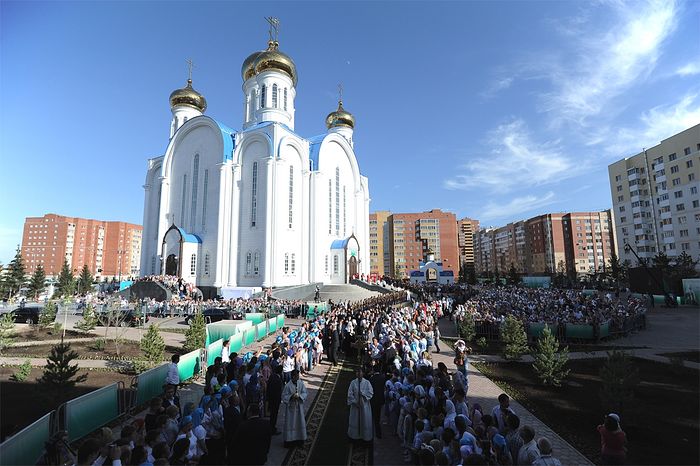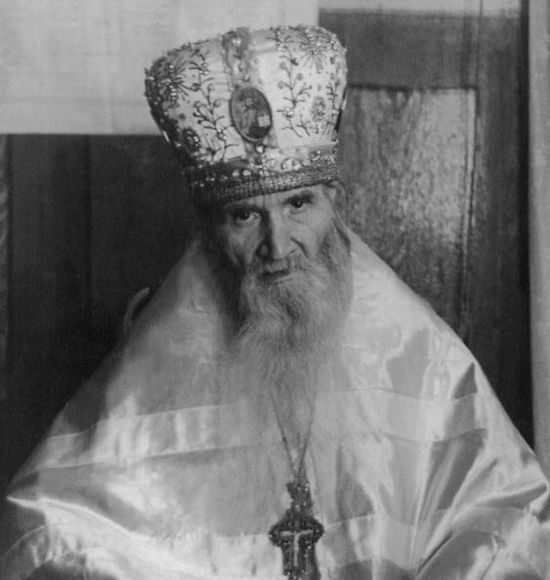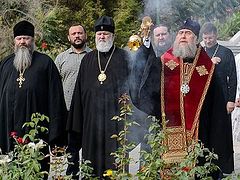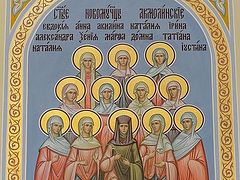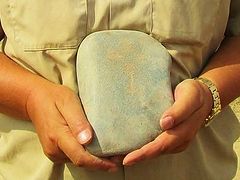When people hear that I am from Kazakhstan, many are surprised and ask, “Are there really Orthodox Christians there?”
But their surprise only increases when I reply that there are over three million Orthodox Christians in Kazakhstan, that there are many holy sites here, and that Christianity appeared in these lands much earlier than in the Slavic lands. It is known from Church history that the apostles Bartholomew, Matthew, and Thomas spread the Gospel teaching in Asia, all the way to the Central Asian regions.
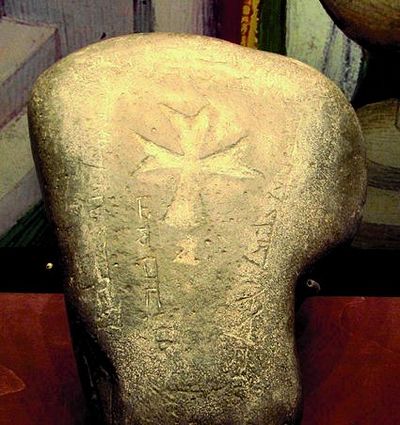 Gravestone from a Christian burial site in Southern Kazakhstan
Gravestone from a Christian burial site in Southern Kazakhstan
The first documented evidence of the presence of Orthodoxy on the territory of modern Kazakhstan comes from the Arabian medieval historian, Al-Biruni. According to his information, there were Christian communities on the lands of Kazakhstan founded at the beginning of the third century.
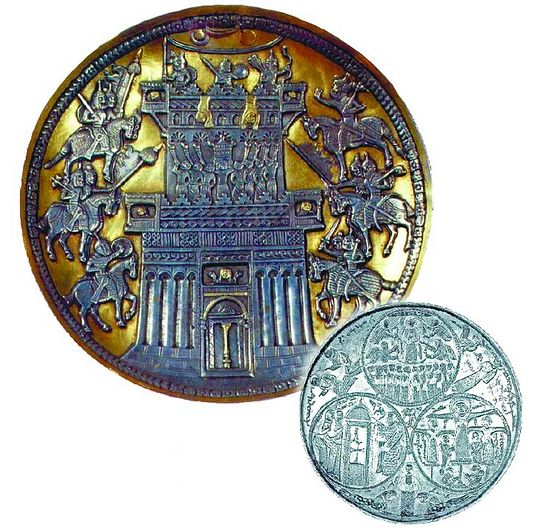 Silver plate with Biblical scenes. 8th c. Southern Kazakhstan
Silver plate with Biblical scenes. 8th c. Southern Kazakhstan
In medieval times, Christianity was spread widely among many of the tribes that settled in Kazakhstan—the Naimans, Kereits, and many other Turkic tribes and peoples. Although the majority of them were heretical Nestorians, there were also some faithful Orthodox communities. In the seventh century a Nestorian Kashgar-Navaket metropolia was formed, in which there were churches located on the territory of Kazakhstan. However, after the Turks accepted Islam, the situation for Christians significantly changed, and in the seventh to eighth centuries, the Christian communities in Central Asia almost completely disappeared.
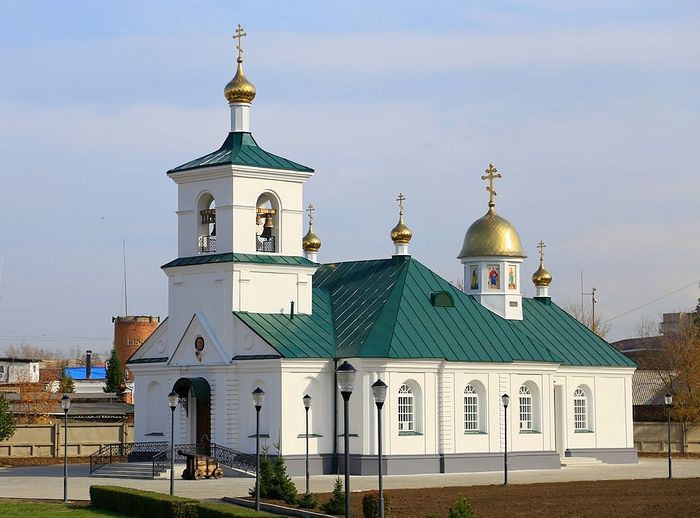 Church of the Holy Trinity, Ust-Kamenogorsk. Consecrated in 1809
Church of the Holy Trinity, Ust-Kamenogorsk. Consecrated in 1809
The rebirth of Orthodoxy on the territory of Kazakhstan is connected with this land’s entrance into the Russian Empire in the seventeenth century. In order to protect Kazakhstan from the “djungar”—Mongolian nomadic peoples who regularly raided these lands—Russian fortifications were built: Semipalatinsk, Ust-Kamenogorsk, and later Petropavlovsk and Pavlodar. These cities are still regional centers of modern Kazakhstan. Of course, Orthodox churches were built in them, and Orthodox communities appeared around them.
 The “Golden Church” of Uralsk (the Church of Christ the Savior). While still tsarevich, Tsar Nicholas II was present at the laying of its foundation stone on July 31, 1891
The “Golden Church” of Uralsk (the Church of Christ the Savior). While still tsarevich, Tsar Nicholas II was present at the laying of its foundation stone on July 31, 1891
We have to give separate attention to Western Kazakhstan. There on the banks of the Yaik (now Ural) River, Cossacks settled; the famous rebel Emilian Pugachev began his wild activities there, and made his raids from there. Because the majority of these Cossacks were Old Believers, many holy sites are connected with the Old Believer schism, but there are also Orthodox churches.
In the south of Kazakhstan, Russian settlements appeared in the mid-nineteenth century. There a military fortification was founded called Vernoye (now Alma-Ata). Settlements were built around this fortification—Sophiskaya, Liubabinskaya, and Nadezhdinskaya (now the cities of Talgar, Kaskelen, and Issyk).
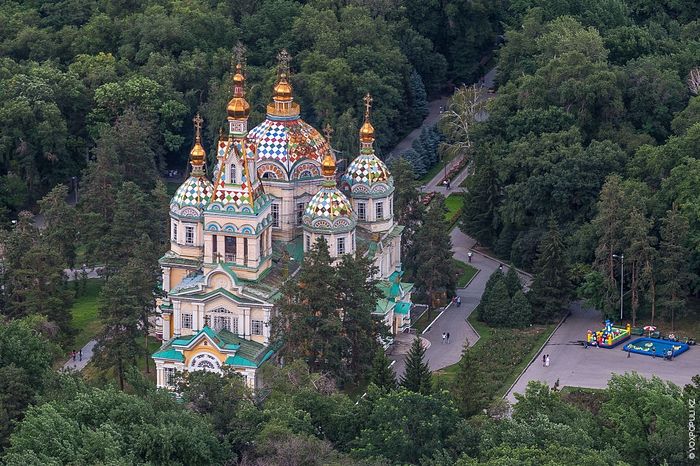 The Ascension Cathedral, Alma-Ata
The Ascension Cathedral, Alma-Ata
In 1867 Vernoye became the center of Semirechensk region—the city of Vernoye. Many churches were built in the city and its surrounding areas but the pearl of them all was the Ascension Cathedral built in 1907. A magnificent cathedral, built from Tian Shen pine, it became one of the largest wooden structures of its time. Particular to the cathedral was its resistance to the many earthquakes that happen in this area. The earthquake of 1910, which turned the one-story town of Vernoye into ruins, literally passed by engineer Andrei Zenkov’s creation—the second tallest wooden structure in the world of that time—and today it continues to delight all those who visit or live in this southern capital of Kazakhstan.
When His Holiness Patriarch Alexiy II visited Kazakhstan, he called the Kazakh steppe an enormous antimens stretched out beneath the open sky. In the twentieth century thousands of the faithful in Christ died here.
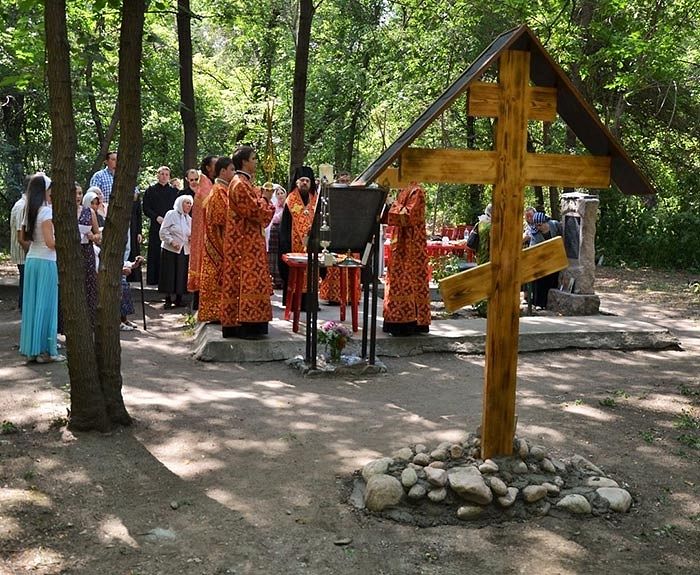 Moleben at the site where Holy Hieromartyr Pimen Vernensky was killed
Moleben at the site where Holy Hieromartyr Pimen Vernensky was killed
By the onset of the persecutions against the Church in 1918, in the city of Vernoye Bishop Pimen (Belolikov) of Vernoye and Semirechensk was murdered. His burial site is unknown, but pilgrims visit the place of his execution—Bauma woods.
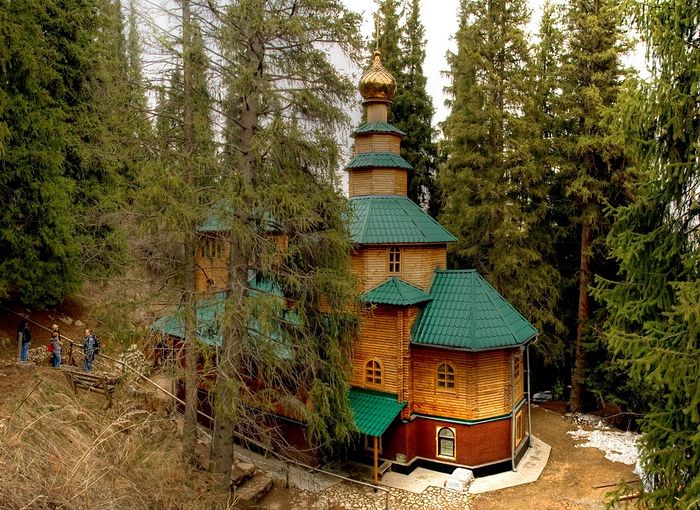 The Sts. Seraphim-Theognost Aksaisk monastery for men
The Sts. Seraphim-Theognost Aksaisk monastery for men
In 1921 on the Kzyl-Zhar Aksaisk pass, near the city of Vernoye, the inhabitants of a mountain skete, Hieromonks Seraphim and Theognost, were killed. The Red Army murderers asked the monks for a place to spend the night, and when the monks fell asleep the murderers stabbed them to death with bayonets. Over the course of the entire Soviet period, their graves were a place of secret pilgrimage. Today, in free Kazakhstan, thousands of pilgrims climb to this mountain skete every year to pray at the relics of the Aksaisk wonder-workers.
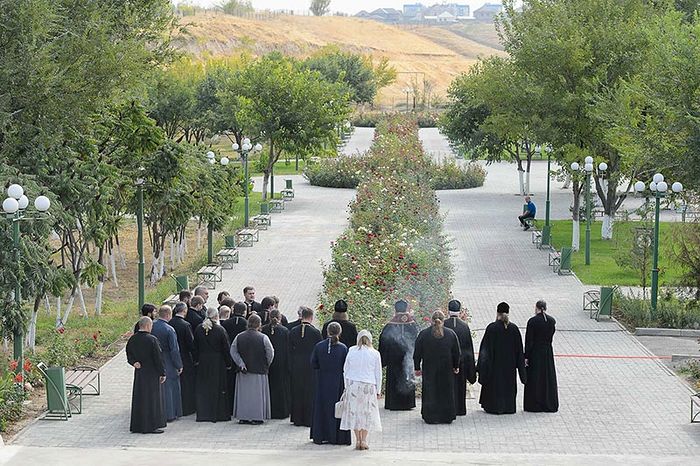 Pannikhida on Licie-Balka—the largest mast execution site of Southern Kazakhstan
Pannikhida on Licie-Balka—the largest mast execution site of Southern Kazakhstan
Among the sites of imprisonment and execution of New Martyrs is Southern Kazakhstan. In the city of Chimkent, St. Kirill (Smirnov) of Kazan, St. Alexiy (Orlov) of Omsk, and many others received a martyr’s death.
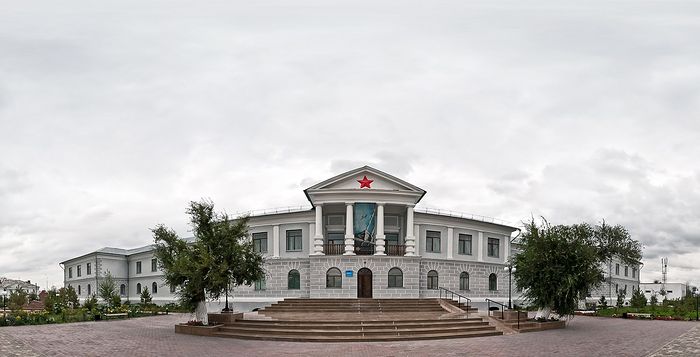 The central headquarters of the Karlag NKVD (now a museum of the victims of political repression)
The central headquarters of the Karlag NKVD (now a museum of the victims of political repression)
The most tragic page in the persecutions took place Central Kazakhstan. To the city of Karaganda, founded in 1934, where sent the “kulaks”—specially resettled hardworking and well-to-do peasants, with the intent of [depriving them of their native villages and all their property and] to build a new city there in 1931. 52,000 peasant families were simply dropped off in the open steppe. People died in the thousands, and only a small number managed to live through the first winter.
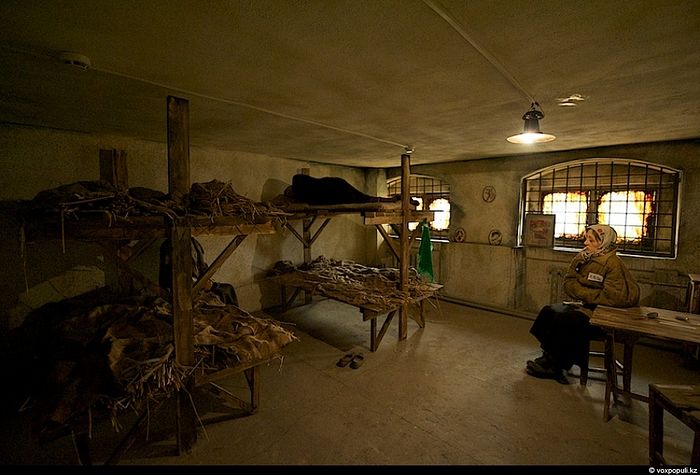 Reconstruction of a standard barrack for prisoners. Museum of the victims of political repressions
Reconstruction of a standard barrack for prisoners. Museum of the victims of political repressions
Furthermore, on the territory of Central Kazakhstan was founded the largest prison camp system of the Gulag—the Karaganda correctional labor camp. The camp occupied an area equal to the size of France, and consisted of many different departments.
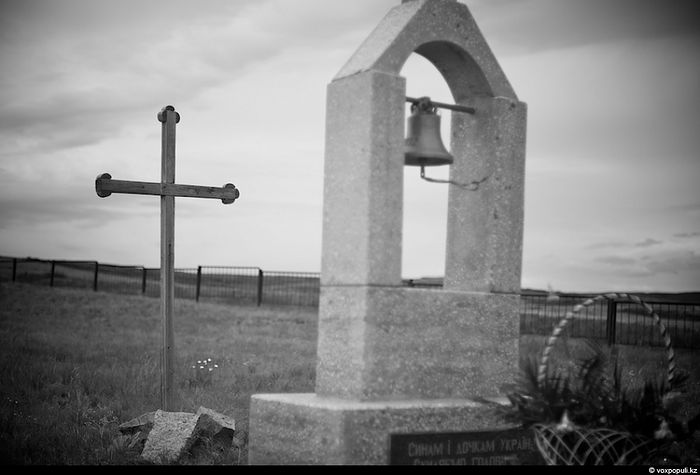 Memorial to all the Ukrainians who died in Karlag, erected at the Karaganda memorial cemetery
Memorial to all the Ukrainians who died in Karlag, erected at the Karaganda memorial cemetery
Over its twenty-eight years of existence, through this camp passed more than a million people of various nationalities and religions, including an enormous amount of clergymen, monastics and laity of the Orthodox Church. Of all the sufferers there are only one hundred canonized. These include Metropolitan Evgeny (Zernov) of Gorkiy, Bishop Damascene (Tsedrik) of Starodub, Bishop Uar (Shmarin) of Lipetsk, and many others.
Amongst the prisoners was one of the last Optina Elders—Archimandrite Sebastian (Fomin). Fr. Sebastian was the cell attendant of two Optina elders—Joseph and Nectarius. After the brothers were exiled from Optina Monastery, Fr. Sebastian was ordained a priest. He was arrested and sent to Karlag for his faith.
Fr. Sebastian spent seven years in the camp, and after his release he remained in Karaganda, where some of his spiritual children live to this day.
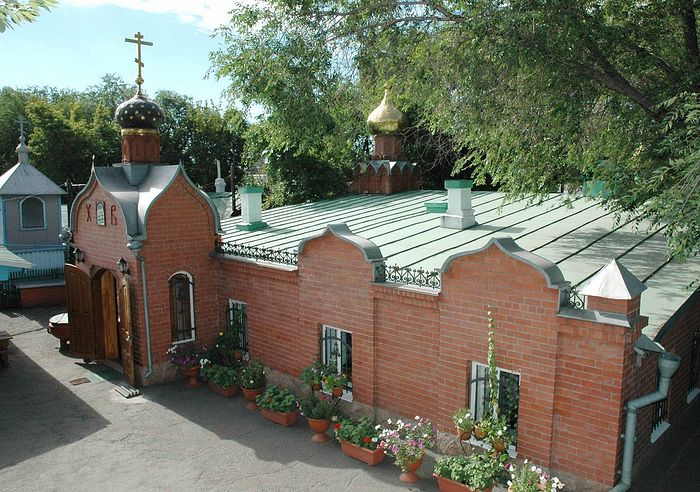 The church built by St. Sebastian of Karaganda (now the Convent of the Nativity of the Theotokos)
The church built by St. Sebastian of Karaganda (now the Convent of the Nativity of the Theotokos)
In 1944, in a new building in the region of Bolshaya Mikhailovka, a small house church was built, and Fr. Sebastian secretly served Divine Liturgy there. Only in 1953 did the faithful manage to obtain official permission to have the Church sacraments and rites served in the Bolshaya Mikhailovka prayer house, and in 1955 they finally received the long-awaited document registering their religious community.
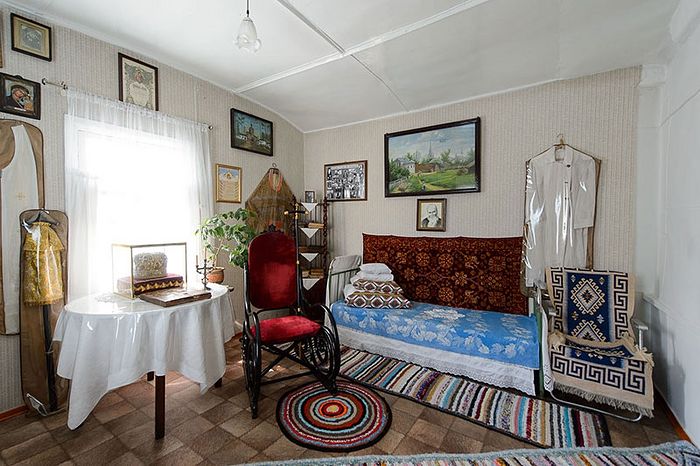 Memorial cell of St. Sebastian of Karaganda in the Nativity of the Theotokos Convent, Karaganda
Memorial cell of St. Sebastian of Karaganda in the Nativity of the Theotokos Convent, Karaganda
Schema-Archimandrite Sebastian departed to the Lord on April 19, 1966 on Radonitsa, having received the Great Schema before his repose. His funeral was served by his spiritual son, Metropolitan Pitirim (Nechayev) of Volokolamsk.
 Reliquary with the relics of St. Sebastian in the Cathedral of the Entry of the Theotokos into the Temple, Karaganda
Reliquary with the relics of St. Sebastian in the Cathedral of the Entry of the Theotokos into the Temple, Karaganda
The Elder was glorified among the monastic saints in 1997, and his honorable relics were then uncovered. They have rested since 1997 in the cathedra in a beautiful reliquary created to resemble the reliquary of St. Sergius of Radonezh.
It is impossible to enumerate all the saints who have shone forth in the land of Kazakhstan. These would include holy hieromartyr Nicholas of Alma-Alta, the elder and Metropolitan Joseph (Chernov), and the nun prisoners of ALZhIR (ACWTM—Akmolinsk camp of the wives of traitors to the Motherland).
Nevertheless, we believe that through their prayers the Lord preserves peace in Kazakhstan and in His Church there.

